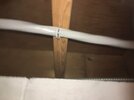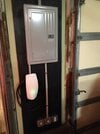That shouldn't be a relevant deciding factor. Whether NEC requires the disconnect is based on the amp rating of the circuit. You have to use a wire type and gauge that meets that amp rating requirement, but that is not directly relevant to the decision for the disconnect.
Yes, it is legal based on this condition: Are the connection lugs you are screwing it into labeled and rated to accept either copper or aluminum wire? A lot are for copper only, so you could not directly use aluminum into those. The Tesla wall connector wire lugs are for copper only. Depending on the type or brand of receptacle, some are for copper only and some others are for either.
Most breakers can be for both (check first). You could run most of the distance in aluminum wire to get to the garage, and then terminate that in a sub-panel. Most sub-panel lugs are rated for AL or copper. There could be significant cost savings there if you're getting up toward 100 feet or more. Then from the sub-panel, you can do the final short run in copper wire to the wall connector or outlet.




